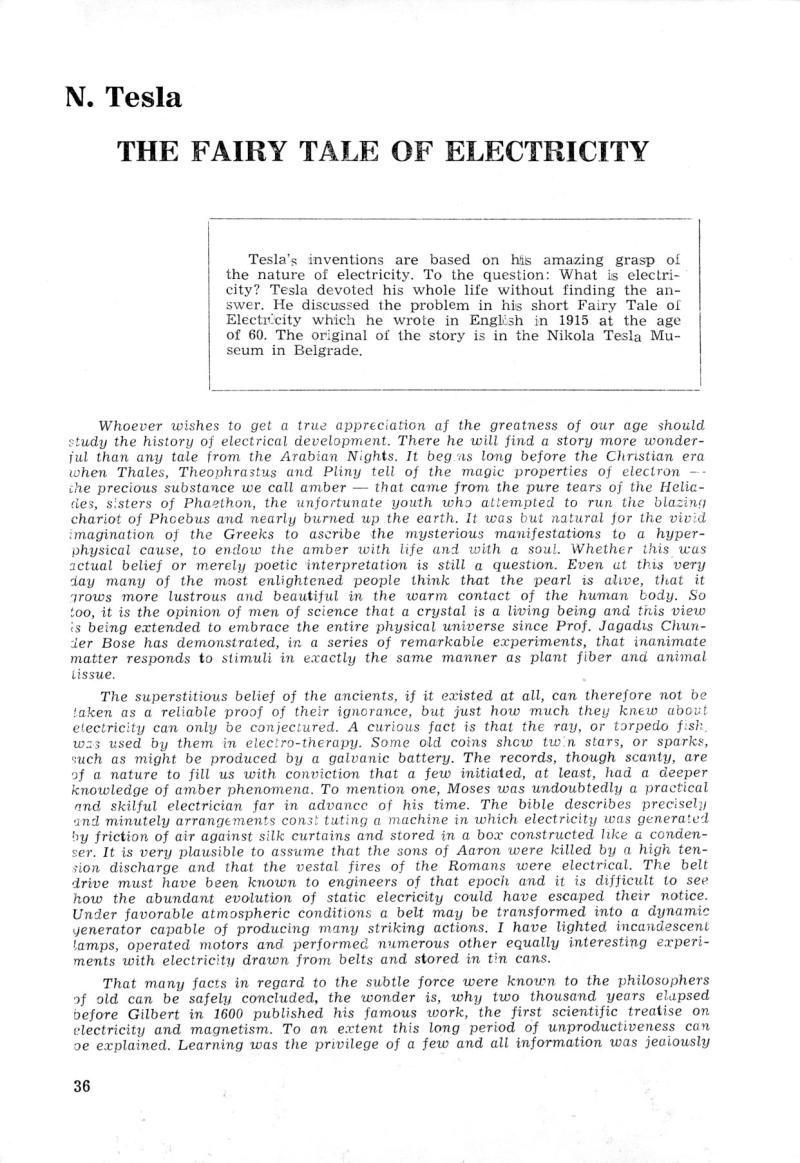
Nikola Tesla Books
N. Tesla
The Fairy Tale of Electricity
Tesla's inventions are based on his amazing grasp of the nature of electricity. To the question: What is electricity? Tesla devoted his whole life without finding the answer. He discussed the problem in his short Fairy Tale of Electricity which he wrote in English in 1915 at the age of 60. The original of the story is in the Nikola Tesla Museum in Belgrade.
Whoever wishes to get a true appreciation of the greatness of our age should study the history of electrical development. There he will find a story more wonderful than any tale from the Arabian Nights. It begins long before the Christian era when Thales, Theophrastus and Pliny tell of the magic properties of electron - the precious substance we call amber - that came from the pure tears of the Heliades, sisters of Phaethon, the unfortunate youth who attempted to run the blazing chariot of Phoebus and nearly burned up the earth. It was but natural for the vivid imagination of the Greeks to ascribe the mysterious manifestations to a hyper-physical cause, to endow the amber with life and with a soul. Whether this was actual belief or merely poetic interpretation is still a question. Even at this very day many of the most enlightened people think that the pearl is alive, that it grows more lustrous and beautiful in the warm contact of the human body. So too, it is the opinion of men of science that a crystal is a living being and this view is being extended to embrace the entire physical universe since Prof. Jagadis Chunder Bose has demonstrated, in a series of remarkable experiments, that inanimate matter responds to stimuli in exactly the same manner as plant fiber and animal tissue.
The superstitious belief of the ancients, if it existed at all, can therefore not be taken as a reliable proof of their ignorance, but just how much they knew about electricity can only be conjectured. A curious fact is that the ray, or torpedo fish, was used by them in electro-therapy. Some old coins show twin stars, or sparks, such as might be produced by a galvanic battery. The records, though scanty, are of a nature to fill us with conviction that a few initiated, at least, had a deeper knowledge of amber phenomena. To mention one, Moses was undoubtedly a practical and skillful electrician far in advance of his time. The bible describes precisely and minutely arrangements constituting a machine in which electricity was generated by friction of air against silk curtains and stored in a box constructed like a condenser. It is very plausible to assume that the sons of Aaron were killed by a high tension discharge and that the vestal fires of the Romans were electrical. The belt drive must have been known to engineers of that epoch and it is difficult to see how the abundant evolution of static electricity could have escaped their notice. Under favorable atmospheric conditions a belt may be transformed into a dynamic generator capable of producing many striking actions. I have lighted incandescent lamps, operated motors and performed numerous other equally interesting experiments with electricity drawn from belts and stored in tin cans.
That many facts in regard to the subtle force were known to the philosophers of old can be safely concluded, the wonder is, why two thousand years elapsed before Gilbert in 1600 published his famous work, the first scientific treatise on electricity and magnetism. To an extent this long period of unproductiveness can be explained. Learning was the privilege of a few and all information was jealously
